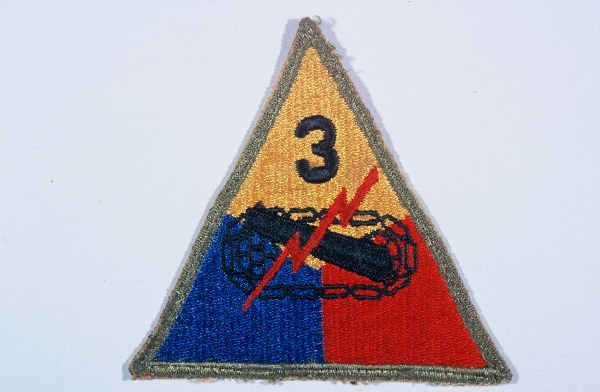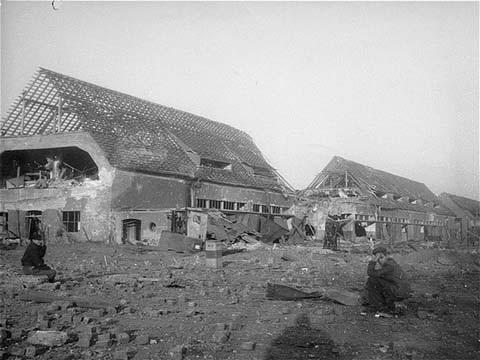
The 3rd Armored Division during World War II
In 1985, the United States Holocaust Memorial Museum and the US Army Center of Military History began a program to honor US Army divisions that took part in the Allied liberation of Nazi camps. The US Army Center of Military History defines a liberating division as one whose official records show its presence at a camp within 48 hours of the first soldier’s arrival. The 3rd Armored Division is among the 36 US divisions that have been recognized to date.
Key Facts
-
1
US, British, Soviet, and Canadian troops encountered concentration camps and other sites of Nazi crimes as they advanced across Europe in 1944 and 1945.
-
2
The Allied soldiers liberated sick and starving camp prisoners from Nazi tyranny. They also provided them with food, clothing, and medical aid.
-
3
The United States Holocaust Memorial Museum and the US Army Center of Military History have recognized 36 US divisions for their role in the liberation of Nazi camps.
3rd Armored Division Campaigns during World War II
The 3rd Armored Division was created in 1941. On June 28, 1944, it landed on the Normandy beaches of France. This was just a few weeks after D-Day (June 6), the massive Allied invasion of western Europe. The "Spearhead" division advanced rapidly, becoming the first US division to enter Belgium. In mid-September, it reached the German border. During the Battle of the Bulge in December 1944, the division was redeployed to Belgium. In March 1945, the 3rd Armored Division advanced into Germany. It captured the city of Cologne and crossed the Rhine River. In April, it advanced eastward into Thuringia in central Germany. It continued to push east until war's end.
The 3rd Armored Division and the Liberation of Dora-Mittelbau
On April 11, 1945, the 3rd Armored Division entered the city of Nordhausen, Germany. There, its troops discovered the horrific conditions of the Dora-Mittelbau concentration camp, as well as those of one of its subcamps (Boelcke-Kaserne) and a German underground armaments factory called Mittelwerk. At Mittelwerk, the concentration camp prisoners were forced to expand tunnels and build rockets for the German war effort.

The Boelcke-Kaserne subcamp was located in an old German Air Force barracks. The SS established the subcamp in early January 1945 to house prisoners for forced labor. By February it served as a camp for dying concentration camp prisoners too weak and sick to be forced to work in the tunnels of the main camp. Thousands of exhausted and starving prisoners also arrived in January on death marches from the Gross-Rosen and Auschwitz camps. At the Boelcke-Kaserne, the SS left prisoners to die without enough food, medical treatment, or beds. On April 3 and 4, 1945, British Royal Air Force bombing raids killed more prisoners. After the air raids, the SS guards immediately fled the camp and left the prisoners to die in the rubble.
The US soldiers arrived a week after the bombing raids. At the site, they found over 1,000 corpses. They also found a few hundred survivors. These people were emaciated and starving. Many were suffering from tuberculosis. Most of these people died shortly after the camp was liberated.
The 3rd Armored Division reported back to headquarters that they had uncovered a large concentration camp near Nordhausen. They also requested the help of the 104th Infantry Division. Together, the 3rd and 104th immediately began transporting some 250 ill and starving prisoners to nearby hospitals. Following liberation, US military authorities forced the local German population to give the dead prisoners a proper burial in the main cemetery of Nordhausen.
Recognition as a Liberating Division
The 3rd Armored Division was recognized as a liberating division by the US Army's Center of Military History and the United States Holocaust Memorial Museum in 1985.
3rd Armored Division Battle Casualty Figures
Hundreds of thousands of US servicemen and women died or were wounded in the fight against Nazi tyranny.
The total number of battle casualties for the 3rd Armored Division in the European Theater of Operations during World War II was 9,243. In this case, “battle casualties” includes all personnel who were unable to fight in battle because they were wounded, missing, captured, or killed.
Among the battle casualties suffered by the 3rd Armored Division, there were 2,147 deaths.
3rd Armored Division Nickname and Insignia
The 3rd Armored Division earned the nickname “Spearhead” because of its role as the spearhead of many attacks in Europe in 1944. It was the first US Army division to enter Belgium and Germany. It was also the first US Army division to capture a German city.
The patch or insignia of the 3rd Armored Division is shaped like a pyramid and represents power. In the center of the patch are three intertwined symbols in black: a tank tread, a cannon, and a lightning bolt. The tank tread symbolizes mobility. The cannon represents firepower. And the lightning bolt stands for shock action (a quick, offensive, military attack that surprises the enemy). The three symbols stand against a tricolored background made of yellow, red, and blue. These colors represent key components of an armored division: cavalry (yellow), field artillery (red), and infantry (blue). The division number appears in black near the top of the pyramid (against the yellow part of the patch).

Footnotes
-
Footnote reference1.
In the aftermath of World War II, the US Department of the Army compiled casualty figures for US Army personnel. The US government published these figures in 1953. The report listed casualty numbers for the US Army for the period from December 7, 1941 (Pearl Harbor) through December 31, 1946, when US President Harry S. Truman officially declared the end of war hostilities. Army Battle Casualties and Nonbattle Deaths: Final Report, 7 December 1941-31 December 1946, Prepared by the Statistical and Accounting Branch, Office of the Adjutant General, Under the Direction of the Program Review and Analysis, Division of the Comptroller of the Army, O.C.S., (Washington: Department of the Army, 1953), p. 3-4, 84-89.
Critical Thinking Questions
What challenges did Allied forces face when they encountered the camps and sites of other atrocities?
What challenges faced survivors of the Holocaust upon liberation?

